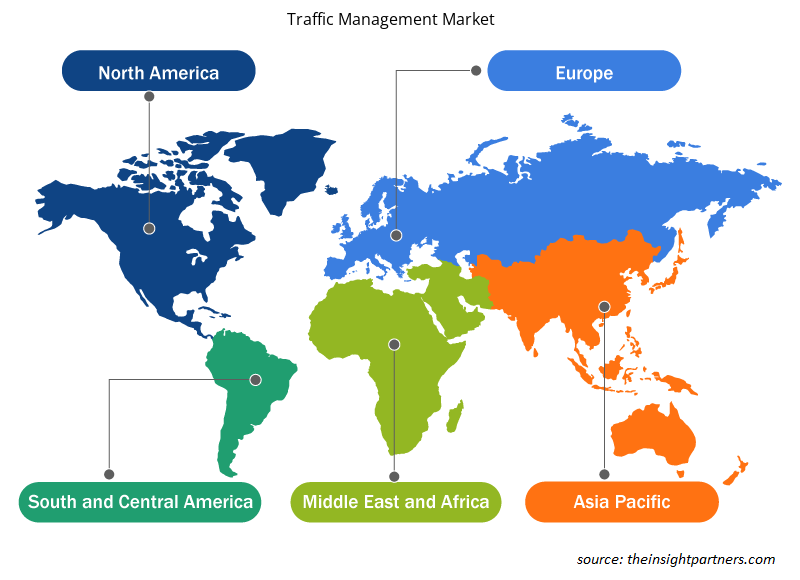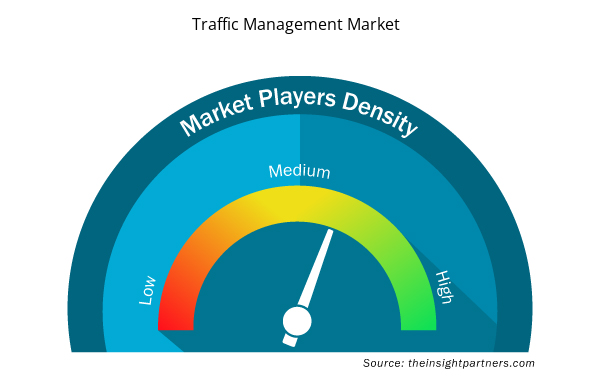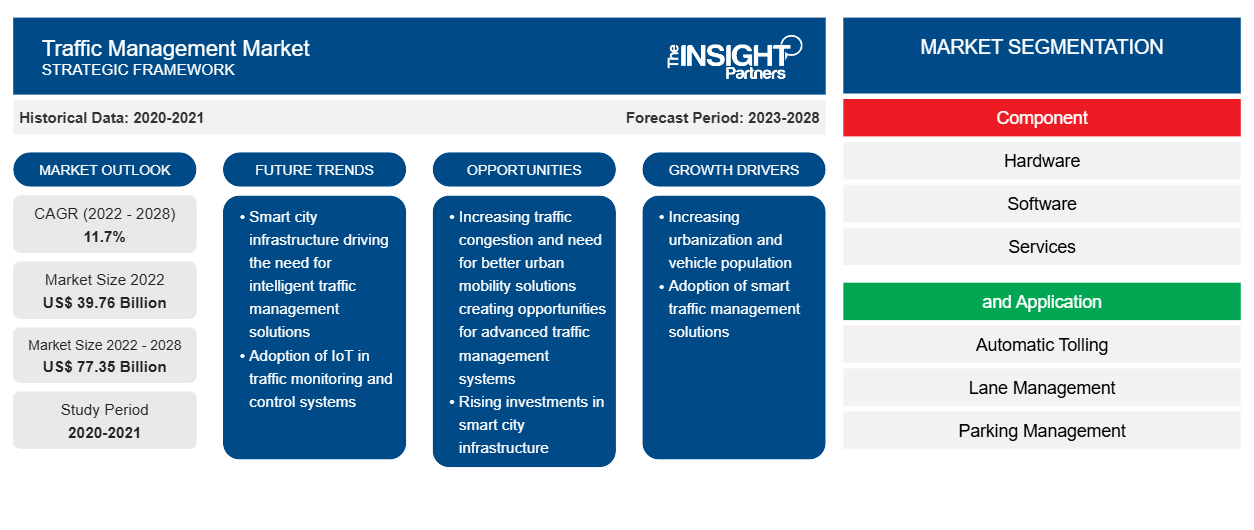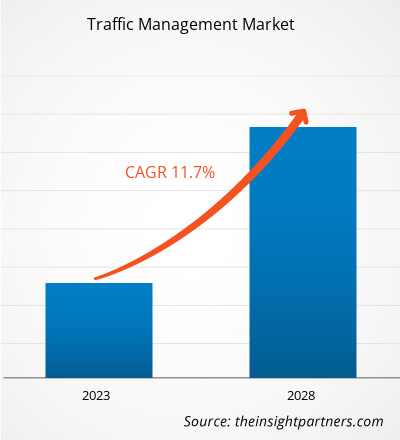من المتوقع أن يصل سوق إدارة المرور إلى 77،346.44 مليون دولار أمريكي بحلول عام 2028 من 39،756.74 مليون دولار أمريكي في عام 2022؛ ومن المتوقع أن ينمو بمعدل نمو سنوي مركب قدره 11.7٪ من عام 2022 إلى عام 2028.
لقد شهدت معظم البلدان توسعًا حضريًا جذريًا على مر السنين، مما أدى إلى شبكات طرق معقدة وازدحام شديد. يؤدي ارتفاع عدد سكان المناطق الحضرية، إلى جانب زيادة ملكية المركبات الخاصة، إلى زيادة عدد المركبات على الطرق. ارتفع عدد السكان في مومباي بالهند من 18.5 مليون في عام 2011 إلى 20.4 مليون في عام 2020، بينما تضاعف عدد المركبات الخاصة تقريبًا خلال هذه الفترة. وبسبب هذه العوامل، ولإصلاحها، من المتوقع نمو سوق إدارة المرور . بالإضافة إلى ذلك، كانت خدمات طلب الركوب من شركات تجميع سيارات الأجرة، مثل أوبر وجراب وأولا وليفت، تتزايد بوتيرة سريعة. كانت هذه الخدمات تحل محل أنظمة النقل الجماعي، مما أدى إلى زيادة في المركبات على الطريق. هذه العوامل تجبر السلطات الحكومية على التواصل مع اللاعبين في سوق إدارة المرور للحصول على حلول فعالة. يمكن تقليل الازدحام المروري بشكل فعال من خلال نظام إدارة مروري قوي، يتألف من برامج وأجهزة استشعار وكاميرات ولوحات عرض. يمكن تثبيت هذه الأنظمة على طريق موجود دون متطلبات تعديل البنية التحتية. وبالمثل، يمكن لنظام إدارة الممرات إدارة تدفق المرور بفعالية من خلال فتح أو إغلاق الممرات، اعتمادًا على معدل حركة المرور في كل نقطة زمنية. وبالنظر إلى المزايا التي توفرها أنظمة إدارة المرور، فمن المتوقع أن يعزز معدل التحضر السريع حجم سوق إدارة المرور بشكل كبير.
تأثير جائحة كوفيد-19 على نمو سوق إدارة المرور
أدى تفشي فيروس كورونا المستجد إلى تعطيل القطاعات الصناعية مثل صناعة السيارات والتصنيع والطاقة والكهرباء والفضاء والدفاع والبناء في عام 2020. أجبر النمو المستمر في عدد مرضى كوفيد السلطات الحكومية في الولايات المتحدة ودول أخرى على فرض عمليات إغلاق صارمة في الأرباع الثلاثة الأولى من عام 2020. وقد أدى هذا إلى انخفاض كبير في النقل في جميع البلدان. أثر تنفيذ تدابير الاحتواء مثل حظر التجارة وقيود السفر والقيود المفروضة على القوى العاملة على أنشطة التصنيع والتوريد والمبيعات لمختلف الشركات، بما في ذلك الشركات التي توفر أجهزة وبرامج وخدمات إدارة المرور. شهد قطاع التصنيع خسائر فادحة بسبب الإغلاق المؤقت للمصانع وانخفاض أحجام الإنتاج، مما أعاق أيضًا إنتاج أنظمة أجهزة إدارة المرور. في الولايات المتحدة، ركزت الحكومة الفيدرالية وحكومات الولايات بشكل أكبر على معالجة الوباء؛ ونتيجة لذلك، تم تعليق تركيب أجهزة وبرامج إدارة المرور مؤقتًا. تضررت صناعة إدارة المرور الأوروبية بشدة بسبب انخفاض الإنفاق على مشاريع البنية التحتية بنحو 20٪، مما أدى إلى تأخير وإيقاف العديد من مشاريع المدن الذكية والطرق الذكية. وقد أدى ارتفاع أسعار أشباه الموصلات وتعطل سلاسل التوريد إلى تفاقم الوضع. ومع ذلك، بدأ سوق إدارة حركة المرور يشهد نموًا إيجابيًا في الربع الرابع من عام 2020.
قم بتخصيص هذا التقرير ليناسب متطلباتك
ستحصل على تخصيص لأي تقرير - مجانًا - بما في ذلك أجزاء من هذا التقرير، أو تحليل على مستوى الدولة، وحزمة بيانات Excel، بالإضافة إلى الاستفادة من العروض والخصومات الرائعة للشركات الناشئة والجامعات
- احصل على أهم اتجاهات السوق الرئيسية لهذا التقرير.ستتضمن هذه العينة المجانية تحليلاً للبيانات، بدءًا من اتجاهات السوق وحتى التقديرات والتوقعات.
رؤى السوق – سوق إدارة المرور
يشهد العالم طفرة في الأجهزة المتصلة، وتستثمر العديد من البلدان في تطوير المدن الذكية. المدن الذكية هي مناطق حضرية متقدمة من الناحية التكنولوجية تستخدم مجموعة متنوعة من أجهزة الاستشعار والطرق الإلكترونية لجمع البيانات والاستفادة منها لتحسين المنطقة. تم تصميم المدن الذكية بخطط طويلة الأجل لإدارة حركة المرور من خلال تحسين النقل والخدمات اللوجستية والحد من الازدحام. وبالتالي، إلى جانب المدن الذكية، تستثمر البلدان أيضًا في تطوير الطرق الذكية لتوفير تنقل أكثر أمانًا للمركبات. على الطرق الذكية، تجمع أنواع مختلفة من أجهزة الاستشعار والأجهزة بيانات متعددة المتغيرات تُستخدم لمراقبة حركة المرور. يمكن أيضًا مشاركة البيانات مع المركبات التي تسير على الطريق، مما يسمح للغواصين والركاب باتخاذ قرارات مستنيرة. وبالتالي، يمكن توقع أن يؤدي التبني المتزايد للمدن الذكية والطرق الذكية إلى تعزيز حجم سوق إدارة المرور.
رؤى قائمة على المكونات
يتم تقسيم سوق إدارة المرور على أساس المكون والتطبيق والجغرافيا. يتم تقسيم السوق، حسب المكون، إلى أجهزة وبرامج وخدمات. يتم تقسيم سوق الأجهزة بشكل أكبر إلى الكاميرات ولوحات العرض وأجهزة الاستشعار؛ علاوة على ذلك، يتم تقسيم سوق البرامج إلى السحابة والمحلية. كانت وكالات حكومية مختلفة تستثمر في ترقية أجهزة إدارة المرور الخاصة بها. كان التوسع الحضري المتزايد وزيادة ملكية السيارات يثقل كاهل الطرق الحضرية. وبالتالي، تعتمد السلطات على الكاميرات الحديثة لتحسين صيانة تدفق المرور وضمان السلامة. يتم نشر كاميرات التعرف التلقائي على لوحات الأرقام (ANPR) بشكل متزايد لتحديد المخالفين أو لتحديد موقع المركبات أثناء تحقيقات الحوادث. غالبًا ما يتم إقرانها بأجهزة استشعار بالليزر لتحديد سرعة السيارة.
من خلال التطبيق، يتم تقسيم سوق إدارة المرور إلى تحصيل الرسوم تلقائيًا، وإدارة الممرات، وإدارة مواقف السيارات ، والمراقبة، وإدارة إشارات المرور ، وغيرها. بناءً على الجغرافيا، يتم تقسيم السوق بشكل أساسي إلى أمريكا الشمالية وأوروبا وآسيا والمحيط الهادئ (APAC)، والشرق الأوسط وأفريقيا (MEA)، وأمريكا الجنوبية (SAM). تعد IBM Corporation؛ Cisco Systems, Inc.؛ Siemens AG؛ Hangzhou Hikvision Digital Technology Co.، Ltd.؛ و Dahua Technology Co.، Ltd. من بين اللاعبين الرئيسيين في سوق إدارة المرور.
رؤى إقليمية حول سوق إدارة المرور
لقد قام المحللون في Insight Partners بشرح الاتجاهات والعوامل الإقليمية المؤثرة على سوق إدارة المرور طوال فترة التوقعات بشكل شامل. يناقش هذا القسم أيضًا قطاعات سوق إدارة المرور والجغرافيا في جميع أنحاء أمريكا الشمالية وأوروبا ومنطقة آسيا والمحيط الهادئ والشرق الأوسط وأفريقيا وأمريكا الجنوبية والوسطى.

- احصل على البيانات الإقليمية المحددة لسوق إدارة المرور
نطاق تقرير سوق إدارة المرور
| سمة التقرير | تفاصيل |
|---|---|
| حجم السوق في عام 2022 | 39.76 مليار دولار أمريكي |
| حجم السوق بحلول عام 2028 | 77.35 مليار دولار أمريكي |
| معدل النمو السنوي المركب العالمي (2022 - 2028) | 11.7% |
| البيانات التاريخية | 2020-2021 |
| فترة التنبؤ | 2023-2028 |
| القطاعات المغطاة | حسب المكون
|
| المناطق والدول المغطاة | أمريكا الشمالية
|
| قادة السوق وملفات تعريف الشركات الرئيسية |
|
كثافة اللاعبين في سوق إدارة المرور: فهم تأثيرها على ديناميكيات الأعمال
يشهد سوق إدارة المرور نموًا سريعًا، مدفوعًا بالطلب المتزايد من المستخدم النهائي بسبب عوامل مثل تفضيلات المستهلكين المتطورة والتقدم التكنولوجي والوعي المتزايد بفوائد المنتج. ومع ارتفاع الطلب، تعمل الشركات على توسيع عروضها والابتكار لتلبية احتياجات المستهلكين والاستفادة من الاتجاهات الناشئة، مما يؤدي إلى زيادة نمو السوق.
تشير كثافة اللاعبين في السوق إلى توزيع الشركات أو المؤسسات العاملة في سوق أو صناعة معينة. وهي تشير إلى عدد المنافسين (اللاعبين في السوق) الموجودين في مساحة سوق معينة نسبة إلى حجمها أو قيمتها السوقية الإجمالية.
الشركات الرئيسية العاملة في سوق إدارة المرور هي:
- شركة أكسيس كوميونيكيشنز
- شركة سيسكو سيستمز
- شركة كيوبك
- شركة داهوا للتكنولوجيا المحدودة
- شركة هانغتشو هيكفيجن للتكنولوجيا الرقمية المحدودة
إخلاء المسؤولية : الشركات المذكورة أعلاه ليست مرتبة بأي ترتيب معين.

- احصل على نظرة عامة على أهم اللاعبين الرئيسيين في سوق إدارة المرور
يركز اللاعبون في سوق إدارة المرور بشكل أساسي على تطوير المنتجات المتقدمة والفعالة.
- في عام 2021، أعلنت شركة Dahua Technology عن تطوير حل شامل لإدارة حركة المرور الذكية والذي تم تطويره من خلال الجمع بين المراقبة بالفيديو والذكاء الاصطناعي والتعرف على لوحات أرقام السيارات ودمج الصور والواقع المعزز وغيرها من التقنيات المتطورة لتلبية الاحتياجات المتنوعة لإدارات إنفاذ المرور الحديثة.
- في عام 2021، كشفت شركة Hikvision، وهي شركة تقدم حلول إنترنت الأشياء وتتخصص في الكاميرات، عن كاميرا All-Rounder ITS، أحدث منتجاتها المرورية التي تهدف إلى تحسين السلامة على الطرق وتدفق حركة المرور. تجمع الكاميرا بين مجموعة متنوعة من المواهب والقدرات، بما في ذلك اكتشاف السرعة، واكتشاف مخالفات المرور، والتعرف الآلي على لوحات السيارات، وتحليل سمات المركبات، كل ذلك في حزمة واحدة.
- التحليل التاريخي (سنتان)، السنة الأساسية، التوقعات (7 سنوات) مع معدل النمو السنوي المركب
- تحليل PEST و SWOT
- حجم السوق والقيمة / الحجم - عالميًا وإقليميًا وقطريًا
- الصناعة والمنافسة
- مجموعة بيانات Excel



Report Coverage
Revenue forecast, Company Analysis, Industry landscape, Growth factors, and Trends

Segment Covered
This text is related
to segments covered.

Regional Scope
North America, Europe, Asia Pacific, Middle East & Africa, South & Central America

Country Scope
This text is related
to country scope.
الأسئلة الشائعة
The traffic management market is expected to reach US$ 77,346.44 million by 2028.
The hardware segment led the traffic management market with a significant share in 2021. It is further expected to dominate the market share over the forecast period. However, software segment is expected to be the fastest growing.
India, China and Italy are expected to register high growth rates during the forecast period.
The US held the largest market share in 2021, followed by Germany.
Asia Pacific is the fastest growing regional market, followed by Europe.
The key players, holding majority shares, in traffic management market includes IBM Corporation; Cisco Systems, Inc.; Siemens AG; Hangzhou Hikvision Digital Technology Co., Ltd.; and Dahua Technology Co., Ltd.
Artificial Intelligence (AI) and Machine Learning (ML) are expected to play a crucial role in the future of the traffic management market. The application of AI and ML in traffic management is still quite nascent, and most countries are yet to adopt the same. However that scenario is changing fast, primarily due to the increasing number of connected cars.
Traffic management market is being driven by the rising urbanization, increasing congestion and growing investment in infrastructure development. Traffic management systems can be installed on an existing road without the requirements of infrastructural modification and thus can greatly aid in reducing congestion.
The global traffic management market was estimated to be USD 39,756.74 Million in 2021, and is expected to grow at a CAGR of 11.7%, during the forecast period 2022 - 2028.
The incremental growth, expected to be recorded for the traffic management market during the forecast period, is US$ 37,589.70 million.
Trends and growth analysis reports related to Technology, Media and Telecommunications : READ MORE..
The List of Companies - Traffic Management Market
- Axis Communications AB
- Cisco Systems, Inc.
- Cubic Corporation
- Dahua Technology Co., Ltd.
- Hangzhou Hikvision Digital Technology Co., Ltd.
- IBM Corporation
- SGS SA
- Siemens AG
- SNC-Lavalin Group
- Teledyne FLIR LLC
The Insight Partners performs research in 4 major stages: Data Collection & Secondary Research, Primary Research, Data Analysis and Data Triangulation & Final Review.
- Data Collection and Secondary Research:
As a market research and consulting firm operating from a decade, we have published and advised several client across the globe. First step for any study will start with an assessment of currently available data and insights from existing reports. Further, historical and current market information is collected from Investor Presentations, Annual Reports, SEC Filings, etc., and other information related to company’s performance and market positioning are gathered from Paid Databases (Factiva, Hoovers, and Reuters) and various other publications available in public domain.
Several associations trade associates, technical forums, institutes, societies and organization are accessed to gain technical as well as market related insights through their publications such as research papers, blogs and press releases related to the studies are referred to get cues about the market. Further, white papers, journals, magazines, and other news articles published in last 3 years are scrutinized and analyzed to understand the current market trends.
- Primary Research:
The primarily interview analysis comprise of data obtained from industry participants interview and answers to survey questions gathered by in-house primary team.
For primary research, interviews are conducted with industry experts/CEOs/Marketing Managers/VPs/Subject Matter Experts from both demand and supply side to get a 360-degree view of the market. The primary team conducts several interviews based on the complexity of the markets to understand the various market trends and dynamics which makes research more credible and precise.
A typical research interview fulfils the following functions:
- Provides first-hand information on the market size, market trends, growth trends, competitive landscape, and outlook
- Validates and strengthens in-house secondary research findings
- Develops the analysis team’s expertise and market understanding
Primary research involves email interactions and telephone interviews for each market, category, segment, and sub-segment across geographies. The participants who typically take part in such a process include, but are not limited to:
- Industry participants: VPs, business development managers, market intelligence managers and national sales managers
- Outside experts: Valuation experts, research analysts and key opinion leaders specializing in the electronics and semiconductor industry.
Below is the breakup of our primary respondents by company, designation, and region:

Once we receive the confirmation from primary research sources or primary respondents, we finalize the base year market estimation and forecast the data as per the macroeconomic and microeconomic factors assessed during data collection.
- Data Analysis:
Once data is validated through both secondary as well as primary respondents, we finalize the market estimations by hypothesis formulation and factor analysis at regional and country level.
- Macro-Economic Factor Analysis:
We analyse macroeconomic indicators such the gross domestic product (GDP), increase in the demand for goods and services across industries, technological advancement, regional economic growth, governmental policies, the influence of COVID-19, PEST analysis, and other aspects. This analysis aids in setting benchmarks for various nations/regions and approximating market splits. Additionally, the general trend of the aforementioned components aid in determining the market's development possibilities.
- Country Level Data:
Various factors that are especially aligned to the country are taken into account to determine the market size for a certain area and country, including the presence of vendors, such as headquarters and offices, the country's GDP, demand patterns, and industry growth. To comprehend the market dynamics for the nation, a number of growth variables, inhibitors, application areas, and current market trends are researched. The aforementioned elements aid in determining the country's overall market's growth potential.
- Company Profile:
The “Table of Contents” is formulated by listing and analyzing more than 25 - 30 companies operating in the market ecosystem across geographies. However, we profile only 10 companies as a standard practice in our syndicate reports. These 10 companies comprise leading, emerging, and regional players. Nonetheless, our analysis is not restricted to the 10 listed companies, we also analyze other companies present in the market to develop a holistic view and understand the prevailing trends. The “Company Profiles” section in the report covers key facts, business description, products & services, financial information, SWOT analysis, and key developments. The financial information presented is extracted from the annual reports and official documents of the publicly listed companies. Upon collecting the information for the sections of respective companies, we verify them via various primary sources and then compile the data in respective company profiles. The company level information helps us in deriving the base number as well as in forecasting the market size.
- Developing Base Number:
Aggregation of sales statistics (2020-2022) and macro-economic factor, and other secondary and primary research insights are utilized to arrive at base number and related market shares for 2022. The data gaps are identified in this step and relevant market data is analyzed, collected from paid primary interviews or databases. On finalizing the base year market size, forecasts are developed on the basis of macro-economic, industry and market growth factors and company level analysis.
- Data Triangulation and Final Review:
The market findings and base year market size calculations are validated from supply as well as demand side. Demand side validations are based on macro-economic factor analysis and benchmarks for respective regions and countries. In case of supply side validations, revenues of major companies are estimated (in case not available) based on industry benchmark, approximate number of employees, product portfolio, and primary interviews revenues are gathered. Further revenue from target product/service segment is assessed to avoid overshooting of market statistics. In case of heavy deviations between supply and demand side values, all thes steps are repeated to achieve synchronization.
We follow an iterative model, wherein we share our research findings with Subject Matter Experts (SME’s) and Key Opinion Leaders (KOLs) until consensus view of the market is not formulated – this model negates any drastic deviation in the opinions of experts. Only validated and universally acceptable research findings are quoted in our reports.
We have important check points that we use to validate our research findings – which we call – data triangulation, where we validate the information, we generate from secondary sources with primary interviews and then we re-validate with our internal data bases and Subject matter experts. This comprehensive model enables us to deliver high quality, reliable data in shortest possible time.


 احصل على عينة مجانية لهذا التقرير
احصل على عينة مجانية لهذا التقرير